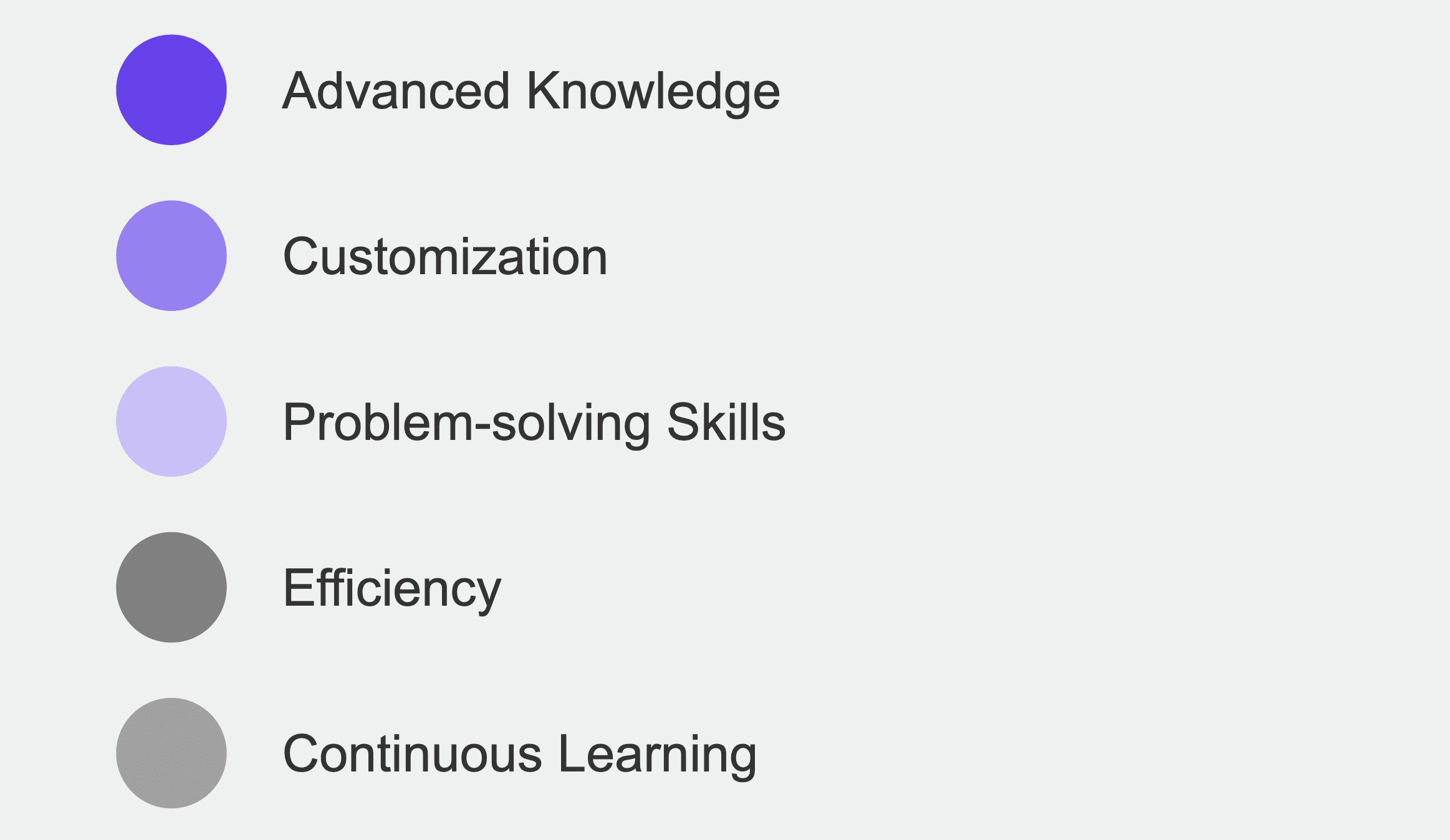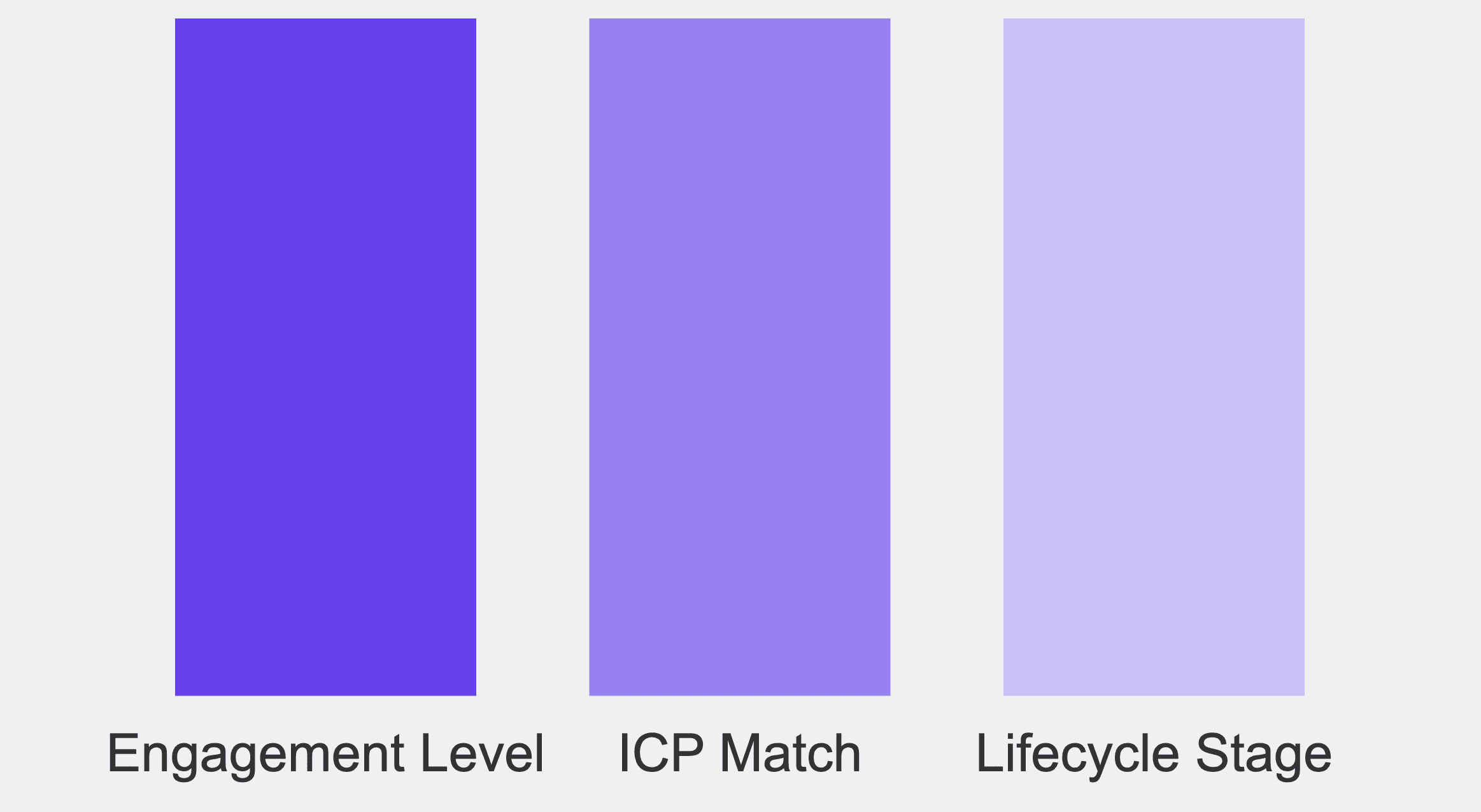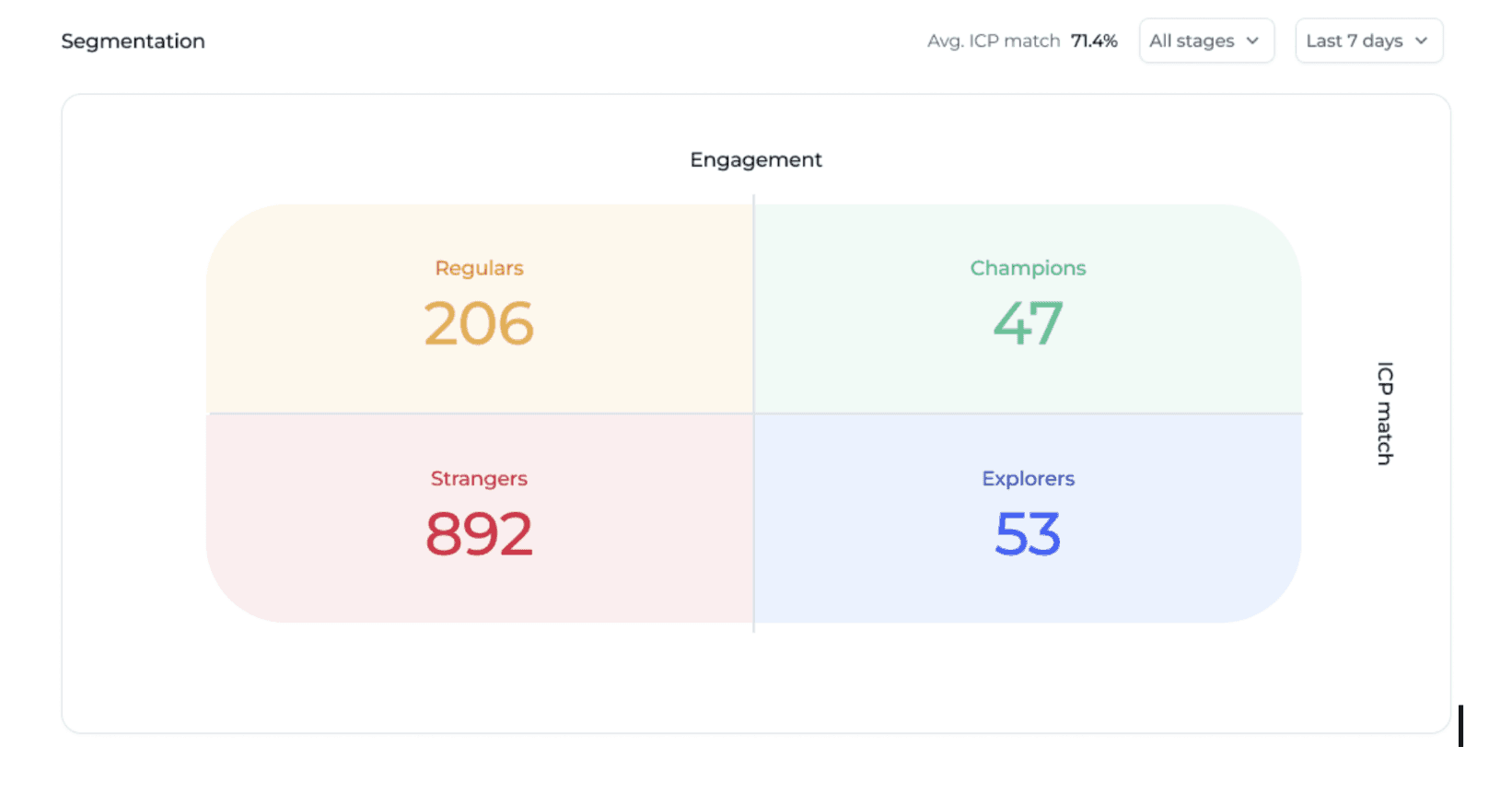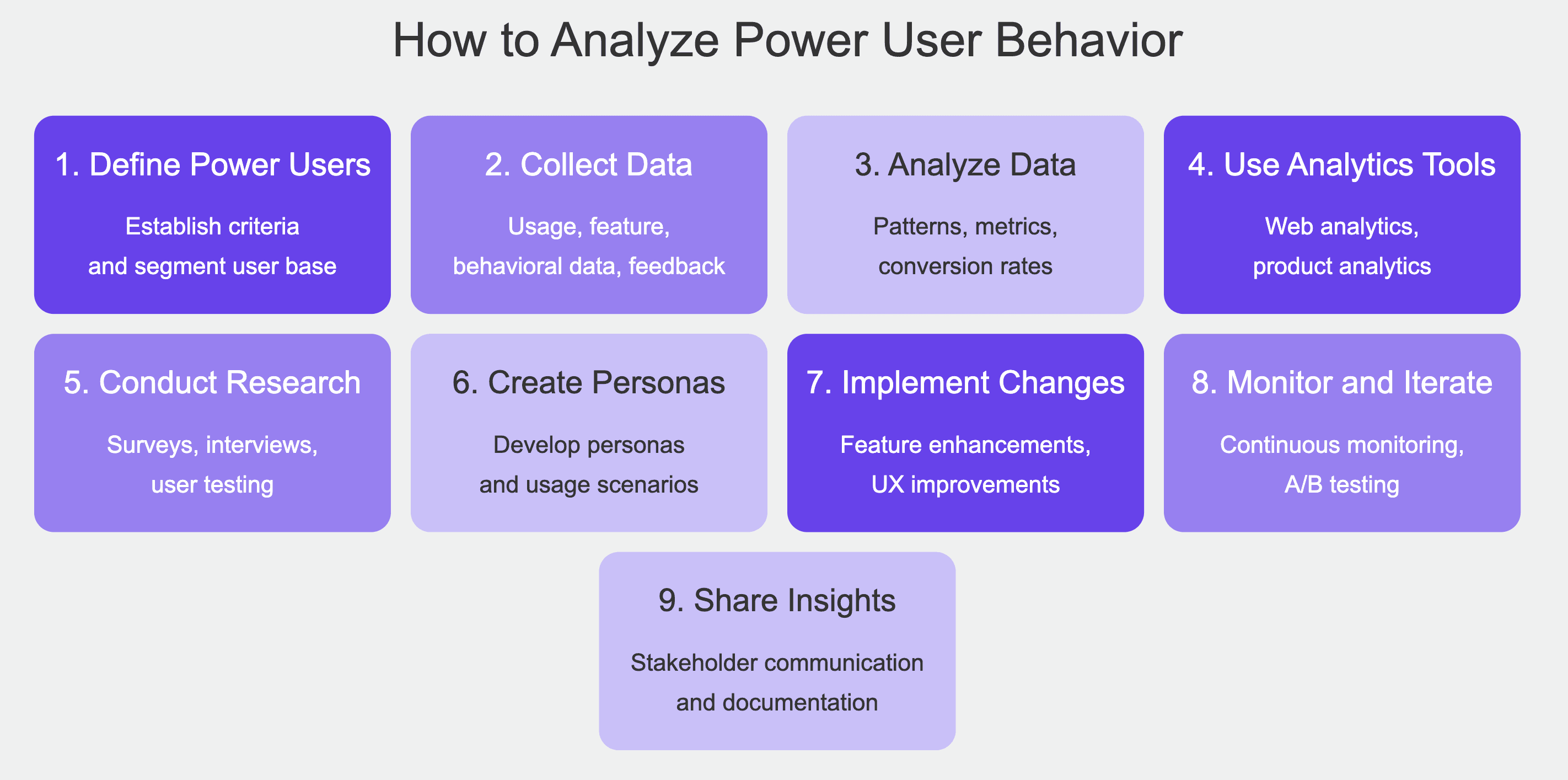
Who Are SaaS Power Users and How to Identify Them?

par
Aleksa Mitrovic
23 sept. 2024
Identifiez et convertissez vos utilisateurs les plus importants
Créer un compte
Product-led growth (PLG) SaaS companies
Product-led growth (PLG) SaaS companies have a low-touch sales model, where the product itself is doing all the interaction with users and converting them into paying customers.
Without having a person get information from users about their usage and needs, to understand what is necessary and how to develop the product further, PLG SaaS depends on the constant collection of data through user tracking or different surveys and forms.
This data is later processed and various strategies are made based on it:
Product development
Marketing campaigns
User experience
If you're running a PLG SaaS company, you're likely having tens of thousands or hundreds of thousands of users signing up for the product and then converting.
Due to the sheer number of your user base, it's essential to focus and prioritize data. Is the feedback of every user equally important? Probably not. It's essential to focus your efforts on the most valuable users and adjust your strategies to their liking.
Why is this important? In today's PLG SaaS industry, product development is becoming a commodity and doesn't have any defensibility as it used to have in the past. Today your main defensibility is having loyal users, that you can turn into raving fans to actively promote your product and establish a vibrant community.
Therefore adjusting your strategies to cater to the needs of the users who can become raving fans is a must-do. Introducing Champions, or Power Users, the type of users who should be the absolute focus of the company.
Important remark: Many PLG SaaS companies make mistakes by taking into account everyone's response into consideration. There were many occasions when I was asked to give feedback on a product even though I wasn't an active user and even some bizarre cases where I was asked to add items and vote for them even though I've never even registered for a product.
Who is a power user in PLG SaaS?
Here's one definition of what is a power user: A power user, or a super user, is a customer that uses a company's software more often and in more effective ways than other users.
In essence, a power user is someone who extensively utilizes advanced features. They often have a deep understanding of the system's capabilities and can customize it to their specific needs.
Here are some common characteristics of power users:

Advanced knowledge: They are familiar with complex features and settings
Customization: They often tweak their systems to optimize performance and efficiency
Problem-solving skills: They can troubleshoot technical issues and find creative solutions
Efficiency: They use shortcuts and automation to accomplish tasks quickly
Continuous learning: They are always seeking to learn new skills and techniques
In essence, a power user is someone who gets the most out of their technology. Usually, you can find this info by using products like Mixpanel, Amplitude, or PostHog.
My personal opinion is that this is a conventional way of looking at Power Users. You'd check across the product the users who are using it the most and then would collect feedback from them to adjust your product roadmap, marketing strategies and user experience.
Why I'd challenge this approach - we've seen numerous times a PLG SaaS company showing us who their power users are based on product usage, or sometimes even in a simplified view who was logging in the most. It was quite common that in that cohort of users, there was quite a mix of different users (based on their profile and if they fit the ICP criteria, and also different lifecycle stages).
The most vivid example is when one of our customers, a generative AI company had a user being by far their most active one across different features, and having logged in thousands of times over the lifetime to date.
They were considering having this person as the most important user to hear feedback for the product roadmap, writing a case study and having a testimonial on the website.
When we dug deeper into the data of the user base, it turned out that this user was a computer science student who was excited about the technology, wasn't using the product how it was intended, wasn't the Ideal Customer Profile and wasn't even a paying customer.
That's the reason why we've challenged this approach with our product. We believe in getting truly the right perspective of Power Users, or how we call them Champions, by combining the three most important aspects of each user.

This is the new way to evaluate Power Users or Champions:
Engagement Level - Normalizing the usage of the product across different features and ranking against other users
Ideal Customer Profile match - Does the user match our target Ideal Customer Profile and to which degree
Lifecycle Stage - Is it a free user, a trial user, a converted user or a churned out user

With this new approach, this would be the new outlook of how we can easily identify our real Power Users or Champions. In the example below, there are 47 of them who are highly engaged and Ideal Customer Profile.
How to analyze the behavior of Power Users?
Analyzing the behavior of power users can provide valuable insights into how your product or service is being utilized, helping you make informed decisions to improve user experience and drive growth.
Here's a step-by-step guide to analyzing power user behavior, in a conventional way:

1. Define Power Users
Criteria: Establish clear criteria for what constitutes a power user. This could be based on frequency of use, depth of engagement, specific features used, or other metrics relevant to your product.
Segmentation: Segment your user base to identify power users. This might involve looking at usage patterns, engagement metrics, or specific actions taken within the product.
2. Collect Data
Usage Data: Track how often and how long power users interact with your product.
Feature Usage: Monitor which features power users engage with most frequently.
Behavioural Data: Collect data on specific actions, such as clicks, page views, form submissions, etc.
Feedback: Gather qualitative data through surveys, interviews, or user feedback forms.
3. Analyze Data
Usage Patterns: Identify trends in usage patterns, such as peak times of activity, most frequently used features, and common user journeys.
Engagement Metrics: Analyze metrics like session duration, number of sessions, and retention rates.
Conversion Rates: Look at how power users convert on key actions compared to other user segments.
Feature Adoption: Determine which features are most popular among power users and why.
4. Use Analytics Tools
Web Analytics: Tools like Google Analytics can provide insights into user behavior, including page views, session duration, and user flow.
Product Analytics: Tools like Mixpanel, Amplitude, or Heap can offer detailed insights into feature usage and user journeys.
Heatmaps: Tools like Hotjar or Crazy Egg can show where users are clicking, scrolling, and spending time on your site.
5. Conduct User Research
Surveys: Send out surveys to power users to understand their motivations, pain points, and feature requests.
Interviews: Conduct one-on-one interviews to gain deeper insights into their behavior and needs.
User Testing: Observe power users as they interact with your product to identify usability issues and areas for improvement.
6. Create User Personas
Personas: Develop detailed personas of your power users to better understand their goals, behaviors, and pain points.
Scenarios: Create usage scenarios to illustrate how power users interact with your product in different contexts.
7. Implement Changes
Feature Enhancements: Based on your analysis, enhance or add features that power users find valuable.
User Experience Improvements: Make UX/UI improvements to streamline the user journey for power users.
Personalization: Implement personalization features to cater to the specific needs and behaviors of power users.
8. Monitor and Iterate
Continuous Monitoring: Continuously monitor the behavior of power users to identify new trends and opportunities.
A/B Testing: Conduct A/B tests to measure the impact of changes and optimize the user experience.
Feedback Loop: Establish a feedback loop to regularly gather and act on insights from power users.
9. Share Insights
Stakeholder Communication: Share your findings with stakeholders to align efforts and drive product improvements.
Documentation: Document your analysis and insights for future reference and to inform ongoing product development.
By following these steps, you can gain a comprehensive understanding of power user behavior and use this knowledge to drive product improvements, enhance user satisfaction, and ultimately grow your business.
Here's a step-by-step guide to analyzing power user behavior, in a new way:
1. Define your ICP
Criteria: Establish clear criteria for what constitutes an Ideal Customer Profile. This could be based on web tracking attributes, onboarding answers, or 3rd party enrichment.
Segmentation: Segment your user base to identify users that match your Ideal Customer Profile.
2. Collect Data
Profile data - Collect 1st and 3rd party data, so there is a clear understanding of the profile of each user so the Ideal Customer Profile match can be evaluated. This is done by collecting the browser data of a user, onboarding answers, or enriching the data with 3rd party providers like Apollo, Clearbit, RocketReach, etc.
Product usage data - Track the most important product usage aspects: session lengths, number of logins, number of key events, etc.
Lifecycle stage - Have the billing data collected, knowing if it's a free user, trial user, or a converted user so you can assign them and evaluate them on different levels depending on their lifecycle stage
3. Analyze data
Connecting the dots - Find the correlation between profile, behavior, and lifecycle stage and you will see clear Champions across the funnel
4. Use Customer Engagement Tool
Insights - Use Customer Engagement Products like Hyperaktiv.ai and get a definite answer to who your Champions or Power users are
Feedback - Send surveys to the Champions to get feedback on how to improve further your product and user experience
After the data is collected, if relevant implement and measure the changes to ensure the progress.
Why is knowing who the power user is important?
Knowing who your power users are is crucial for several reasons, as they play a significant role in the success and growth of your product or service. Here are some key reasons why identifying and understanding power users is important:

1. Product Improvement
Feature Prioritization: Power users often provide valuable insights into which features are most important and useful. This helps in prioritizing feature development and improvements.
Bug Reporting: Power users are more likely to discover and report bugs and issues, helping you maintain a high-quality product.
2. User Retention
Engagement: Power users are typically highly engaged with your product. Understanding their behavior can help you identify what keeps users engaged and how to replicate that experience for other users.
Loyalty: Power users are often your most loyal customers. Keeping them satisfied can lead to higher retention rates and long-term customer relationships.
3. Revenue Growth
Monetization: Power users may be more willing to pay for premium features or services. Understanding their needs can help you develop monetization strategies that appeal to them.
Upselling: Identifying power users can help you target them with upsell opportunities, such as advanced features or additional services.
4. Feedback and Innovation
Quality Feedback: Power users often provide high-quality, actionable feedback. They can offer insights into what works well and what needs improvement.
Innovation: Power users may have unique use cases or needs that can inspire new features or product innovations.
5. Marketing and Advocacy
Word-of-Mouth: Power users are often enthusiastic advocates for your product. They can generate positive word-of-mouth marketing, which is highly effective in attracting new users.
User-Generated Content: Power users may create content, such as tutorials, reviews, or blog posts, that can help promote your product.
6. Customer Support
Efficient Support: Understanding the needs and behaviors of power users can help you provide more targeted and efficient customer support.
Self-Help Resources: Power users may benefit from advanced self-help resources, such as detailed documentation or advanced tutorials.
7. Community Building
Engagement: Power users can be instrumental in building and maintaining a strong user community. They often participate in forums, social media groups, and other community platforms.
Leadership: Power users may take on leadership roles within the community, helping to answer questions, provide support, and foster a positive environment.
8. Competitive Advantage
Differentiation: By catering to the needs of power users, you can differentiate your product from competitors. This can be a significant competitive advantage.
Market Insights: Power users can provide insights into market trends and emerging needs, helping you stay ahead of the competition.
9. Resource Allocation
Efficient Resource Use: Knowing who your power users are can help you allocate resources more effectively. You can focus on features and improvements that have the most significant impact on user satisfaction and retention.
10. User Experience
Personalization: Understanding power users allows you to personalize their experience, making your product more valuable and relevant to them.
User Journey: Mapping the user journey of power users can help you identify and address pain points, improving the overall user experience.
In summary, knowing who your power users are is essential for driving product improvements, enhancing user satisfaction, fostering loyalty, and ultimately growing your business. By understanding and catering to the needs of power users, you can create a more valuable and successful product.




